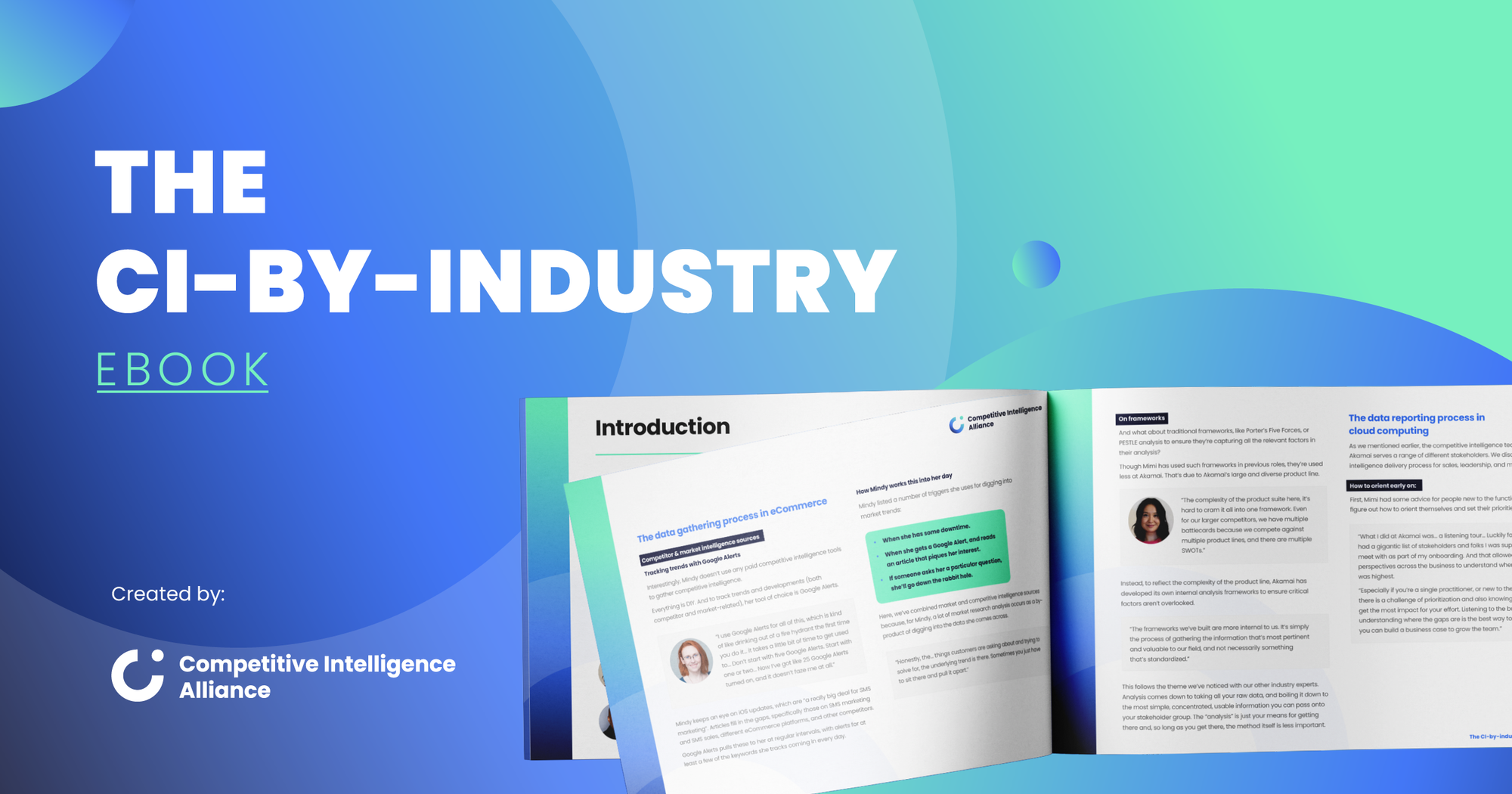How do you explain competitive intelligence to others?
In practice, competitive intelligence is arguably best understood as a perpetual cycle, with no clear end or beginning, where each element flows into the next.
But what does this cycle look like?
In this article, we’ll walk through each stage of the competitive intelligence cycle, informed through conversations with competitive intelligence professionals from our community.
Here’s what we’ll cover:
- What is the 5 step competitive intelligence cycle?
- Each of the five steps in detail.
- How to iterate over and repeat the process.
What is the 5 step competitive intelligence cycle?
Let’s examine each phase in detail:
1) Orientation (reviewing and reassessing)
You might think, since you’re working with a cycle and not a linear process, that you could start anywhere.
This is technically true. But you’ll waste time if you start anywhere other than orientation.
This is because, before you start pouring time and resources into collecting data and putting it to use, you need to figure out what kind of data you need to collect.
What to assess
Seen through a different lens (one where you’ve been through one cycle already, let’s say), orientation is the same as reviewing and reassessing factors like:
- What worked well last time?
- What will you do differently this time?
- What information do you have now that you didn’t have before?
- Do you need to repeat aspects of the prior cycle, or deduplicate your efforts?
Other considerations
But there are other considerations, too. Especially if this is your first time applying competitive intelligence practices at this business. Considerations like:
- What information already exists within the business?
- Where do we want to be, as far as the goals of the business are concerned?
- What does success for my competitive intelligence program look like?
- What information do we need to prioritize gathering to help us move from where we are now to where we want to be?
- Which direct and indirect competitors should we prioritize during our competitor research to get the most business value out of the competitive intelligence process?
All this preparatory work (or review and reassessment), is necessary for getting the most out of all other stages of the competitive cycle.
2) Data gathering
The next stage is to gather intelligence.
Once you know what information you need, and on which competitors, you can go about collecting it using the competitive intelligence sources available to you.
Sources you might use
Internal sources of competitive intelligence are a great place to start. You might use field intelligence from your sales team and customer relationship management (CRM) software. You might talk to customers to find out why they’re choosing particular competitors instead of you.
If you work in a Software as a Service (SaaS) business, you’re in luck. Software companies tend to publish detailed changelogs and help documentation on their websites for anyone to read. This gives you objectively correct information about what your competitors are investing time and money into, as well as how their product is changing over time.
Tried and trusted intelligence-gathering methods you might also use include:
- Social listening tools and tactics.
- Perusing your competitors’ websites.
- Setting alerts for press releases and announcements on industry news websites.
What to do if your competitors have no online presence
But what do you do if your competitor has no online presence to speak of?
Christopher Link is Research and Insights Manager at Interlace Health, and he dealt with this exact problem.
"Data on competitors is always the absolute trickiest thing." Interlace Health's primary competitor "[has] such little information out there. They don't do press releases... they just have no sophisticated, modern media presence. That is weirdly typical in this space.”~Christopher Link, Research and Insights Manager, Interlace HealthHere are the sources he relies on to get around this problem:
- Tax information.
- SEC filings.
- Healthcare databases.
- SEO and SEM data.
- Industry news websites.
- Internal win/loss program.
- Customer research.
Don’t stop gathering
While the concept of competitive intelligence as a cycle, or flywheel, is better than that of a linear process, it’s not perfect. And for no part of the process is this more true than the Data Gathering phase.
In The New Competitor Intelligence, Leonard M. Fuld argued for what he called a “Three-Part Philosophy” of competitive intelligence. The first of these three parts was “Constancy”:
“You must gather information constantly, day-in, day-out, and not just during the traditional strategic planning cycle… your competitors are not so polite as to wait till next year at the same time to once again compete. They compete every day…”💬What this is really like in practice...As you move through the competitive intelligence cycle, you’re likely to look down and realize you’ve become an octopus. Even as you’re reviewing and analyzing, you’ll be analyzing fresh information, even as more is coming in, while preparing to report on findings from last week.So don’t stop gathering information, and automate as much of the gathering process as possible to create more overhead for yourself in other parts of the cycle.3) Data analysis and processing
Raw data isn’t particularly useful. It’s the usable intelligence you extract from that raw information that can contribute towards better strategic decisions being made and a stronger competitive advantage for your business. That said, we were surprised to find many practitioners don’t actually have much of a formal analysis process.

CI-by-Industry eBook
Grab your copyDownload your copy to learn...
- 😰 Why field intelligence can be dangerous, and how to use it the right way. (Page 24)
- 🙅♂️ Why you should think twice before having reps from this team on a win/loss call. (Page 24)
- 🤖 The truth about automation, and how much time tools can really save you. (Page 22)
- 🤯 The surprising key skill every one of our industry experts said was crucial for CI success. (Page 66)
Instead, they tend to analyze on the fly. As they’re reading through their Google Alerts, taking stock of new information coming in, yesterday’s information is in the back of their minds. When you gather and engage with data constantly, you develop an intuitive sense for what’s important, and when things are changing.
When something new is on the horizon, an expert competitive intelligence practitioner can sense it. Ok, perhaps not with 100% accuracy, but they’ll get it right enough of the time for it to be of measurable business value.
But let’s say you haven’t developed such a sixth sense for your market yet. Where do you start?
Option 1: Use frameworks
There are a handful of competitor analysis frameworks you can use and extract value from today. Even if you find in a couple years’ time that you’ve outgrown them, or developed them into something of your own, a starting point might be all you need.
Here’s a short list:
- PESTLE analysis
- Competitor SWOT analysis
- VRIO analysis
- Competitive landscape analysis
These frameworks are high-level, and the data you gather in step two is more likely to help you complete one of these analyses than the methods are to help you make sense of your data.
If you’re really stuck when it comes to converting raw data into intelligence and business strategy, check out our training materials on Competitive Intelligence Certified: Masters.
Option 2: Ask questions
If using a formal framework like those listed above seems too… formal, you might prefer asking simple questions to direct your analysis. Questions like:
- What does this tell me about the market or industry as a whole?
- What larger trends am I seeing that it would benefit our leaders to know about?
- What opportunities might there be that we’re missing, or uniquely positioned to take advantage of?
- What problems does this information suggest we have, with our internal products, our positioning, or even our processes? Which of these, if fixed, would constitute the biggest win for the business?
4) Data reporting
When you’ve made sense of the data you have, and have answers to questions like those listed above, it’s time to report your valuable findings to key stakeholders.
Sometimes, you’ll have quick, actionable wins with the potential to hugely benefit your organization. Other times, you’ll just have business-as-usual status updates, or small competitor developments to report to decision makers.
Not every report needs to be a home-run
We spoke to the experts in our competitive intelligence community, and they assured us that you don’t need to provide a big win at every company meeting. Not every update needs to be a home run. Often, the small stuff is enough.
But when you think you’re onto something big, don’t sit on it. Share it with as many people as possible to ensure it gets implemented, actioned, and can contribute to your competitive edge. Otherwise, the outcome will be the same as if you never collected the information at all.
5) Actioning
Finally, it’s time to action your valuable suggestions.
It depends on your company culture but, as the competitive intelligence professional, you might not need to be too involved in these steps.
Oversee the process to ensure success
Some level of oversight is important, though. Especially as you become more senior. You’re the one with the intimate knowledge of your primary competitors, and with the overarching trends playing out in your market.
It only takes one small miscommunication to push a project off course. If things a team strays too far from the intended path, bringing them back on track can take a monumental effort. Be there to oversee things and catch it early, though, and a gentle word will be enough to course correct.
Finally: Repeating the process (reviewing and reassessing)
And, just like that, we’re back to where we started. Time to review and reassess.
In the beginning, you oriented yourself, aligning your vision and priorities with those of the business. Now, you’ll do the same thing. With the key difference that this time you’ll do it with the added experience of all you’ve learned through your first iteration of the competitive intelligence cycle.
Have faith that you and your process will improve
Rinse and repeat this process and, with many repetitions, you’ll effectively sand down the rough edges and remove the friction from your process. Over time, it’ll become more effective, and you’ll notice that you become more effective too.
You’ll notice subtle clues faster in your data. You’ll more effectively automate or delegate parts of your process. You’ll prove the business need for competitive intelligence and win more resources.
So, if you feel stuck, just keep going!
Check out some of these resources for more inspiration and information:
Get industry insights





.png?v=40ae029d56)